(2928 products available)





















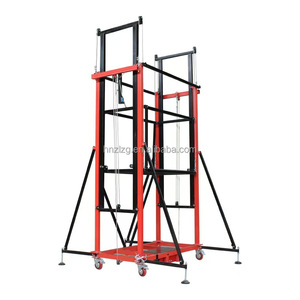
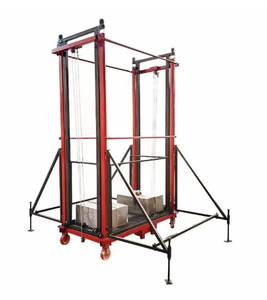

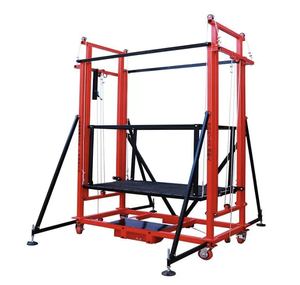
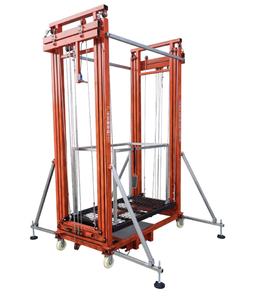
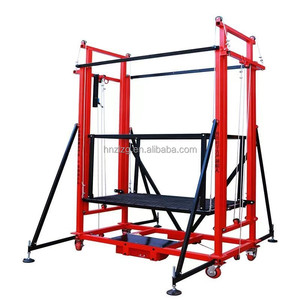







































































































































































































Staircase scaffolding is a kind of temporary structure used to access and work on elevated areas around staircases, making it very versatile. The most common types of scaffolding are as follows:
This type of scaffolding is ideal for long, straight staircases. It consists of a single tower that runs parallel to the stairs, providing a stable working platform along the entire length of the staircase. This scaffolding is quick and easy to assemble and is well suited for tasks that require access to the full length of a stairway, such as painting or repairs.
This scaffolding is designed for staircases that have landings or are wide enough to accommodate two parallel towers on either side of the stairs. The double straight stair tower provides increased stability and a wider working platform than a single tower. It allows workers to access both sides of the staircase simultaneously, making it ideal for tasks that require work on multiple levels.
These are designed for curved or spiral staircases. They are customized to match the curve or spiral of the specific staircase, providing a continuous and stable working platform that follows the shape of the stairs. Single curved stair towers are a safe and efficient way to access and work on unique stair designs. They are well-suited for tasks that require precise access to a curved or spiral staircase, such as maintenance or renovations.
This type of scaffolding is ideal for staircases of varying heights. It consists of adjustable components that can be modified to fit different stair configurations. It allows for quick and easy adjustments to ensure a secure fit on the stairs, regardless of the height or angle. Temporary stair towers are versatile and suitable for locations with different types of staircases.
These are equipped with wheels that allow them to be moved from one location to another, providing flexibility and convenience. They are suitable for applications where access to multiple staircases is needed, as they can be repositioned easily. Mobile stair towers provide a stable working platform that can be easily transported, making them ideal for tasks that require access to different areas.
Stair scaffolding can be customized to fit any staircase design. Curved or straight staircases can be accommodated by adjusting the angle and height of each component. This ensures a secure platform is installed alongside any staircase, allowing workers to safely access and work on the stairs and surrounding areas.
Adjustable stair scaffolding is required for staircases of different heights and widths. The components can be modified to fit the specific dimensions of a staircase, providing a secure and stable platform for workers. Kwikstage staircase can accommodate both indoor and outdoor staircases with various configurations, such as straight, spiral, or L-shaped.
Many scaffolding for stairs is lightweight and easy to transport. This allows workers to move the components to different job sites and assemble them quickly. Portable stair scaffolding is ideal for projects that require workers to access and work on different areas of the stairs, as it can be disassembled and moved to a new location easily.
Stair scaffolding is designed to provide a safe working environment for users. Handrails are installed along the entire length of the staircase to prevent falls. Non-slip surfaces are also used to cover the steps and platforms, reducing the risk of accidents. Toeboards and guardrails further protect workers from falling objects. Additionally, stabilizers and outriggers are used to secure the scaffolding to the ground and maintain its stability.
Materials resistant to corrosion such as galvanized steel or aluminum are used to manufacture stair scaffolding. This ensures that the components can withstand outdoor elements and remain in good condition for many years. Scaffolding for stairs is also treated with powder coating to prevent rust and corrosion, increasing its lifespan.
Stair scaffolding components are designed to be assembled and disassembled quickly. Many scaffolding systems use a simple locking mechanism that allows components to be connected without the need for tools. This reduces downtime and allows workers to set up the scaffolding efficiently.
Stair scaffolding is designed to conform to safety regulations and standards. It meets the requirements of OSHA, which ensures that workers are protected from falls and other hazards. Compliance with these regulations is essential for avoiding fines and creating a safe work environment.
Staircase scaffolding is a critical tool in the construction and maintenance industry. Its applications are vast, ranging from simple home renovation and repair to complex construction projects. Here are some common usage scenarios:
Builders need scaffolding to construct new staircases in residential and commercial buildings. It provides a safe and stable platform for workers to install risers, treads, and handrails. Stair scaffolds allow workers to access hard-to-reach areas and ensure precise construction.
Scaffolding is commonly used when renovating or repairing existing staircases. It permits workers to safely remove old worn-out components, such as treads and risers, and install new ones. Also, it provides access to the staircase structure for repairs and reinforcement.
When constructing exterior stairs leading to buildings or outdoor spaces, scaffolding provides crucial support. It allows workers to safely build the stair stringers, treads, and risers. Also, it is suitable for construction in uneven or elevated locations.
Property owners and facility managers use scaffolding to inspect and maintain staircases. It offers a stable platform for detailed inspections of structural integrity and safety. Additionally, it allows for routine maintenance tasks, such as painting, sealing, and tightening loose components.
When staircases are damaged due to natural disasters or accidents, scaffolding provides immediate support for repair and restoration. Emergency response teams can quickly install stair scaffolds to assess damage, make temporary repairs, and restore access to affected areas.
Preservationists and restoration experts rely on scaffolding when restoring historic staircases in old buildings, palaces, and museums. It offers a stable platform to conduct detailed restoration work while ensuring the staircase's authenticity and historical significance.
Scaffolding can be used to create temporary staircases or access points in construction sites or events. By using specially designed components, such as modular stair systems, scaffolding can be easily adapted to create safe temporary staircases for workers or event attendees. This is especially useful when permanent staircases are not yet built or need to be closed for maintenance or repair. MiTower stairs can be used in such scenarios.
Choosing the right scaffolding for stairs requires careful consideration of several factors. These factors include:
The height and length of the staircase should be considered. The scaffolding should be tall enough to reach the top of the stairs with some additional height for safe ascending and descending. The length should also be enough to cover the entire staircase. It is important to choose a scaffolding system that can be easily adjusted to fit different staircase dimensions.
The material used for the scaffolding will determine its weight, durability, and stability. Steel scaffolding is very strong and durable, making it a good choice for long-term use. It can be used on both indoor and outdoor staircases. However, it is very heavy and requires more effort to set up and take down. It is also more expensive.
Aluminum scaffolding is lighter than steel and very resistant to rust. It is easy to move around and transport. It is a good choice for outdoor staircases. However, it is not as strong as steel and can be more expensive. Wood scaffolding is affordable and has a natural grip. However, it requires more maintenance and is not as durable as steel or aluminum.
The scaffolding system should be very stable and safe for workers. Look for models with a wide base and adjustable legs to provide more stability on uneven surfaces. The base should have non-slip feet to prevent the scaffolding from moving. The platform should have guardrails and handrails for extra support. The stairs themselves should also have a non-slip surface.
The scaffolding should be easy to set up and take down. Look for models that come with easy-to-follow instructions. It should have a simple locking mechanism and a tool-less design. Some systems come with color-coded components to help workers assemble the parts correctly. It should also be lightweight enough for one or two people to transport.
When choosing scaffolding for stairs, it is important to consider the regulations and safety standards in the area. Some areas require a professional to set up and take down the scaffolding. This is especially important when using scaffolding for commercial projects. Check the local building codes to ensure the scaffolding complies with all safety standards.
A: Safety is a top priority. Here are some safety tips for using scaffolding on stairs:
A: No, it is not safe to install scaffolding on stairs without professional help. Proper training is required to ensure the scaffolding is installed correctly and safely. Scaffolding on stairs requires special skills to ensure it is stable and will not cause accidents. Installing scaffolding on stairs without professional help can lead to serious accidents and injuries.
A: Regular maintenance is important to ensure the scaffolding is in good condition. Proper storage is important to prevent rust and other damage. Scaffolding must be inspected before use to ensure they are safe. Clean the scaffolding after use to remove dirt and other materials that can cause damage.
A: The types of scaffolding for stairs include modular scaffolding, frame scaffolding, and tube and clamp scaffolding.
A: There are many materials used for scaffolding, but aluminum is popular because it is lightweight and durable. It is easy to move and does not require a lot of maintenance, as is the case with steel. Aluminum scaffolding is resistant to rust and lasts for many years. It is ideal for stair construction because it can be assembled and disassembled easily. Peri up stairs systems represent another option that provides flexibility and durability.